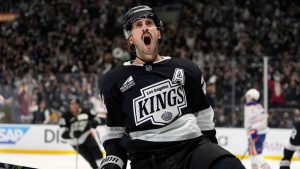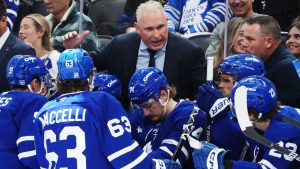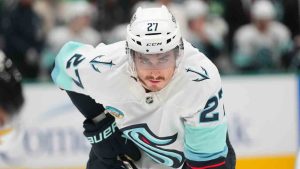It perhaps took a little longer than we all would have liked, but on Friday night the NHL and NHLPA reached a tentative agreement on a return to play plan for a 2020-21 season, with a target start date of Jan. 13.
The agreement, which still needs to be ratified by the NHLPA and the Board of Governors, covers rules and roster guidelines, such as a four-to-six player taxi squad in case of injury or positive tests, no proration of salaries, a player opt-out option, and a tolling option which allows teams to decide whether or not to retain the year on a player’s contract who opts out.
If the agreement is ratified by both sides in the coming days, it will chart a clearer path to the start of a new season, and in rather short order. But before we get to the drop of the puck there are a number of unfinished storylines still to resolve, and some to look forward to.
https://twitter.com/FriedgeHNIC/status/1340132558932217858
Rosters are still being constructed for the coming season and more than a few notable contracts — either UFA or RFA — still have to be signed.
So, even after the business between the NHL and the NHLPA is resolved, there will be much team and player business to get to.
[snippet id=4167285]
WHERE WILL CANADA’S TEAMS PLAY?
It seemed like the surest thing of this whole negotiation was that the coming season would bring us an all-Canadian Division to avoid cross-border travel between the U.S. and Canada. But as Sportsnet’s Chris Johnston reported Thursday night, the NHL is also having to prepare for the possibility that all seven Canadian teams will have to relocate south of the border for the season, if local health authorities don’t sign off on the NHL’s return to play plan.
While a tentative agreement has been reached between the NHL and NHLPA on the new season, the Canadian team issue remains unresolved.
“I’ve heard varying reports on that today,” Elliotte Friedman said of the Canadian question on the FAN 650’s The Program. “I’ve heard some progress. I’ve heard progress in some and not others.
“Worst case scenario is all Canadian teams move to the United States. It’s possible there is a hub. It’s possible maybe one of the teams gets moved to another city. All of this stuff is on the table, it’s just not sorted out yet.”
REMAINING FREE AGENTS
In any normal season the unrestricted free-agent class would be mostly bare this long after the market opened, but for many reasons there are still a handful of serviceable and impactful players available to sign.
Because of the flat cap at $81.5 million, 16 NHL teams are within $2 million of the ceiling. Because of those tight squeezes, some players could still be available at a discount via trade, which is another market for teams who hold cap space to target.
The conditions for the remaining UFAs couldn’t be much worse, but some opportunities have opened in the past few days. With Henrik Lundqvist having to miss the season due to a heart condition, the Washington Capitals will either have to promote an unproven netminder from within the organization, or explore veteran options on the free agent market, which we explored this week. The Florida Panthers inked Anthony Duclair to a bargain one-year, $1.7 million contract after his 23-goal season in Ottawa.
And Alex Steen’s retirement means they can use his contract on LTIR, which would open up a little cap room to go after a replacement forward.
The most motivated buyers — those with cap space and a clear mandate to win now — have mostly already spent their money and made their investments for the 2020-21 season. But there are still a number of teams with cap room who will be looking to fill out their rosters and take advantage of any favourable market conditions. There certainly are some interesting names available to them.
Mike Hoffman: The best scorer left in unrestricted free agency, Hoffman was well on his way to back-to-back 30-goal seasons when the pandemic halted the regular season, finishing with 29 in 69 games. Do the Blues now make sense?
Travis Hamonic: The right shot defenceman led all Calgary Flames blueliners in average shorthanded ice time last season and would be a great add for anyone needing a shutdown player. His offensive upside is low, with just 12 points last season, but this acquisition would be made with an eye to improving on defence. The Canucks had interest before bringing Nate Schmidt in, while it’s believed Hamonic still wants to play in the west.
Sami Vatanen: For a little more offence from the back end, right shot Sami Vatanen is still available. The New Jersey Devils’ leader in average power play ice time from the blue line had a strange season, where he was traded while injured at the deadline to the Carolina Hurricanes, but only played seven games with them in the summer playoffs.
Mikael Granlund: Maybe a good buy-low target, Granlund is just two seasons removed from scoring 67 points and did score 17 goals in 63 games with the Nashville Predators in 2019-20.
Zdeno Chara: Look, we all expect him back in Boston on a cheap, one-year deal if Chara decides to play another season. He’s staying close to the community, delivering Thanksgiving pies last month.
[snippet id=3816507]
BIG UNSIGNED RFAs AND CAP SQUEEZES IN NEW YORK AND TAMPA BAY
While there are some solid players still available on the UFA market, the remaining unsigned RFAs has the better pool of players at the top. If ever there was an off-season for a competitive offer sheet to put a team in a bind this is it, and it’s telling we’ve yet to see one.
Some RFAs do take this long to sign in normal circumstances — Brayden Point, for instance, didn’t re-up with the Lightning until late September last year.
The difference now, of course, is that it’s really not clear how some of these players will fit under the cap. Trades will likely need to be made to clear room in some of these cases.
The two teams that are in a particular bind are the Tampa Bay Lightning and the New York Islanders. The Lightning’s situation is very well documented, and we took a look at their squeeze after Mikhail Sergachev signed his bridge contract a few weeks back.
The Islanders are in a similar spot, with just $3.9 million in projected cap space under the regular-season limit and RFA Mat Barzal still to sign (spoiler alert: he’ll get more than that). If Point is any indication, Barzal could command around $7 million on a short-term bridge deal. A shorter term is believed to be where Barzal is headed in this market.
“That’s still what I’m hearing,” Elliotte Friedman said on Sportsnet 960 The FAN’s Big Show. “They still have a lot of cap issues, so that’s what I expect.
“I just don’t know how they’re going to be able to get to a Barzal six- or seven-year number without major surgery. Even a two- or three-year deal could be somewhat painful surgery.”
Teams can go over the regular-season cap by 10 per cent in the off-season, so there is room for the Islanders to work with now, though that window is rapidly closing. Some trading would need to happen before the season starts to make them compliant. The Islanders already have nine players on the roster making $5 million or more and four of their six highest-paid forwards have full no-trade clauses. We have to know exactly what Barzal’s price point is before understanding how much money New York would have to shed, but this is setting them up to make a losing trade.
Barzal and Tampa Bay’s Anthony Cirelli have been the two most talked about RFAs because of the cap pinches their teams will face after signing them, but they’re not the only RFAs of note still out there. The Columbus Blue Jackets’ Pierre-Luc Dubois had somewhat of a breakout season in 2019-20 and really announced himself in the playoffs, where he posted 10 points in 10 games and centred a line that gave the Toronto Maple Leafs and Lightning fits.
The difference with Dubois and the other two is that the Blue Jackets have the cap space to get a deal done without having to make a trade that allows the dollars to work. Columbus has $9.2 million in salary cap room and Dubois remains the only player unsigned on the team.
Here are some of the other notable RFAs…
Vince Dunn: Young puck-mover with plenty of offensive upside and a great skater, Dunn is coming off his entry-level contract but the Blues aren’t exactly brimming with cap space after signing Torey Krug from the UFA market, especially if they seek a replacement for Steen. Dunn’s name has also been linked in trade rumours, so a re-signing is no guarantee.
MacKenzie Blackwood: Last season was a coming out party for Blackwood, who played 47 games for the Devils and posted a .915 save percentage and 2.77 goals-against average. He’s 24 and is the clear future of the crease in New Jersey. They have over $17 million in cap space so that’s not an issue here. And Blackwood, a young goalie coming off his ELC, shouldn’t be overly expensive yet.
Ethan Bear: He was one of the great surprises out of Edmonton last season, leading all NHL rookies in average ice time per game and locking down a top-four role on the team. The Oilers are right up against the cap, too, but defencemen generally get bridge deals on their second contracts that help keep AAV down. That is likely to happen here as well, though some other roster move would need to accompany it.
CAP REALITIES AROUND THE LEAGUE
The crunches being felt by these teams who still have important contracts to figure out is a big deal but according to Cap Friendly 10 teams are currently over the regular season spending limit. Some of those teams will be able to move roster pieces around to the farm or to LTIR to get right, while others will still have trades to make. None of them will have much wiggle room.
With the cap staying flat at $81.5 million, GMs who built and planned their rosters under the belief that the upper limit would continue to rise are in tough right now. The trade market is thin and unfavourable if you’re looking to shed dollars. This is why the Vegas Golden Knights had to trade Nate Schmidt to the Vancouver Canucks for a future third-round pick, after signing Alex Pietrangelo.
Transactions have been mostly stale for the past number of weeks, but now that we have more clarity on next season and what the financial picture is, we should get ready for the action to pick up again shortly.
“Once this gets ratified…you’re going to see some movement,” Friedman said.
[radioclip id=5025675]
AND WHAT WILL THE TRADE MARKET BE LIKE THIS SEASON ANYWAY?
Trades are difficult to pull off in normal times, but now there could be quarantine and travel rules to contend with.
Think about it — if the Canadian division does happen, how open would those teams be to trading with their American counterparts, knowing that any acquired player would have to quarantine for two weeks upon arrival (barring other grants from the government). And if they can’t afford to wait that long for a player to cross the border, would they want to trade with teams in their division, knowing they will be facing them a number of times?
These considerations may be less of an issue in the U.S., but any border crossing will add a layer of complexity, and local rules could lead to some delay anywhere.
For Tampa Bay to become cap compliant, Alex Killorn’s name has been mentioned in the trade rumour mill. They placed Tyler Johnson on waivers months ago, but he went unclaimed. Can they find a deal for him now?
The Arizona Coyotes explored the possibility of trading Oliver Ekman-Larsson in the off-season, but he has a full no-move clause on his contract and set a deadline for any trade to occur. That date has long since passed, but would he consider opening it again, especially if the Coyotes falter?
Notable players in the final seasons of their contracts who could possibly be found as rentals by the trade deadline include Taylor Hall, who was in a similar position last season and was dealt from New Jersey to Arizona. He signed a one-year deal with the Buffalo Sabres, but if they fail to take a step up again, would they have to sell Hall for futures? Consistent goal scorer Kyle Palmieri of the Devils is also in the last season of his deal, which is attached to a modified no-trade clause, and he could be caught up in rumours (again) this season.
The fact the Seattle expansion draft looms on the horizon next off-season could also lead teams into proactive trades. In Winnipeg, Patrik Laine is in the final season of his contract before becoming RFA eligible again, and to avoid any difficult choices in the off-season, could they strike a deal that includes bringing back much-needed defensive help?
Penguins GM Jim Rutherford, one of the more active dealers in the league, recently discussed why he thinks this year’s trade market could be quieter than normal.
“It’s probably more like football than ever,” he told The Athletic. “It’s probably going to be more where you set your team and that’s going to be your team.”
It’s also not yet clear when the trade deadline will be — or when any of the critical dates are beyond training camp and season start. Usually set for the end of February, the trade deadline likely will be pushed back a little further.
[radioclip id=5025700]
CONTINUED INTRIGUE IN THE GOALIE MARKET
In October, we wrote about why this was the year of the netminder, and we saw a number of them change places. This will continue to be an interesting season at the position, to follow those who changed addresses, to see what comes next for the pending UFAs, and the expansion draft ramifications of it all.
In Toronto, Frederik Andersen enters the season on the final year of his contract and with surprisingly much to prove. Last season was his worst yet on the Leafs, following three years of remarkable regular season consistency. Was that the start of a decline, or a blip on the radar? The Leafs have Stanley Cup hopes as well, but have yet to get out of the first round with this core and this goalie, and so it will be a crucial year for them to decide if Andersen is their guy moving forward, or if they have to go in a different direction.
In Florida, Sergei Bobrovsky perhaps has the most to prove, though he has the security of a big-money, long-term contract. After signing that $10 million AAV in the summer of 2019, Bobrovsky was a disaster with the Panthers, posting a .900 save percentage that was well below his normal level. Will the two-time Vezina winner recover and transform his team’s outlook or, at 32 years old, is that contract always going to be an issue?
Young goalies are also looking to make their mark around the league. Both New York teams (Igor Shesterkin for the Rangers, Ilya Sorokin for the Islanders) are transforming at the position, Washington (Ilya Samsonov), is being forced to skew younger after Lundqvist had to step away, and Vancouver’s Thatcher Demko will be looking to build on a heroic playoff performance where he had to step in for an injured Jacob Markstrom.
These stars of the future join the likes of Carter Hart (Philadelphia), Elvis Merzlikins and Joonas Korpisalo (Columbus) and MacKenzie Blackwood (New Jersey), who have already played full years and shown plenty of promise. And keep an eye out in Minnesota for 24-year-old Kaapo Kahkonen.
Markstrom himself signed with Pacific Division rival Calgary this off-season, where he hopes to take that team to heights it hasn’t seen in years. Holtby joined the Canucks on a two-year contract and hopes to re-establish himself as an upper-echelon netminder — but if he shows any level of stable improvement, will that lead the Kraken to choose him as their goalie?
As it stands, next season’s UFA goalie market will include the likes of Andersen, Tuukka Rask, Jordan Binnington, Philipp Grubauer and Pekka Rinne, among others. Assuming the cap remains flat, the market for each of these players is unclear. Does this current climate mean they are more likely to settle and stay, or will anyone want to test the situation and see what they can get in free agency?
[relatedlinks]



 5:30
5:30